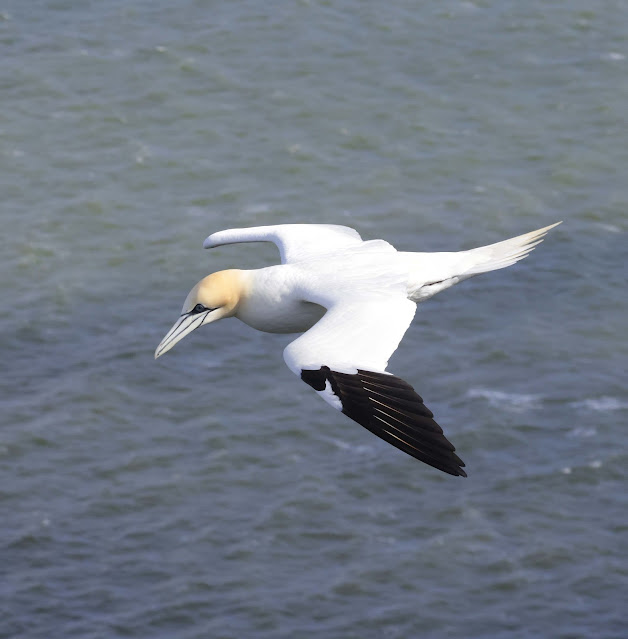After breakfast we left Ako's B and B and drove a couple of miles to the RSPB's Bempton Cliffs Reserve which lies along the top of some very impressive chalk cliffs reaching, at their highest point, almost 100 metres above the North Sea.
The weather was not so kind today with rain and wind promising to be our constant companions, so much so we abandoned any birding by late morning, preferring to drink coffee in the visitor centre cafe and watch the prolific Tree Sparrows that are such a feature of the reserve, especially in the bushes around the visitor centre where many nest boxes have been erected for them.
In fact the whole area around Bempton is a Tree Sparrow hotspot and they are even to be found in the hedgerow by our B and B, which they share with some House Sparrows. The surrounding farms are home to them too. We used to have good numbers of them in my home county of Oxfordshire but for unknown reasons they have almost completely died out despite supplemental feeding.It's really strange how they seem to thrive in and around Bempton but not in Oxfordshire and its surrounding counties.
The next day was free of rain but the wind had become eye wateringly fierce. Nevertheless we decided on a return to Bempton Cliffs and got there early, well before the RSPB had opened up their visitor centre.The wind was cold and from the northwest and once we had walked down to the clifftop it was buffeting us, tugging and pulling at our clothing and blowing into our backs with such force you could lean backwards into it and still remain upright.
It was both elemental and exhilerating at the cliff edge and we were, unsurprisingly the only two on the clifftop. Due to the wind and its direction the Gannets were flying at head height and very close to us, coming right into the edge of the cliff, making use of the wind currents.Their absolute control was a perfect demonstration of their mastery of the ever changing air flow and updraughts. They could stall and hang in the air motionless with partially open wings, held by the wind's violence then spread their wings wide to drop and plane away on a tailwind, into a wide sweep over the sea, thence to return once more, face into the wind.
For an hour I stood, the irritating attentions of the wind forgotten, enjoying this close contact with the natural world and yet another seabird spectacle. A rain shower, coming from the north and out to sea formed a rainbow that moved toward us across the surface of the sea but dissipated, as if a mirage, long before it reached the cliffs.
Smaller numbers of Puffins, Guillemots and Razorbills came and went from the cliffs.Many Guillemots chose to form close packed flotillas, their torpedo shaped brown and white bodies floating on the sea far below. They seemed to be waiting, perhaps for the time when the urge to breed would prove irresistible and propel them to a very different habitat to that which is natural to them. Weeks of standing on dusty cramped cliff ledges were in prospect where they would hardly move as they protected a single egg and then chick amongst many others of their kind. Some had already forsaken the sea and were forming dense lines of slender upright bodies, shoulder pressed to neighbour's shoulder, on impossibly narrow ledges..It was all beginning again, another year, another renewal, for the birds another generation and for me a spiritual renewal.
Intrinsically bound with the visual spectacle is an accompaniment of sound and smell. The triumvirate of a seabird colony. The wind carried the querulous, sharp high cries of the Kittiwakes upwards from their nest ledges while the rhythmic growling of the Gannets, a sound that was never absent from the entire length of the cliffs was almost soothing.
Thankfully the Gannets here have not suffered greatly from avian flu but the Kittiwakes fared rather worse but still were here in reasonable numbers.One can but hope the worst is over as to lose all this would be unbearable
We walked the entire length of the cliffs that were encompassed by the reserve.The sun by mid afternoon so very bright and the wind become almost gale force. In the end it was too much effort and with but a couple of wind blown wheatears and a hyperactive weasel to show for our labours, we gave in and returned to our accommodation.
In the early evening Mark banged on my door and excitedly informed me a Barn Owl was flying in the field right in front of our windows. So it was. Panic! Where was my camera? Locked in Mark's car! I grabbed his keys from him and shot downstairs, retrieved the camera from the car and from the porch which provided perfect shelter from the wind, photographed the owl to my heart's content.
The wind, previously troublesome was now my friend as the Barn Owl spent the next twenty minutes hunting the fields right in front of our B and B and came wonderfully close, allowing me to get as many action images as I could possibly have wished for.
Tomorrow we would be leaving for home.Time seemed to have passed so fast.































Brilliant Barn Owl photos Ewan, amongst the best I've seen
ReplyDeleteThanks Richard. I see from your blog you are still travelling the world and seeing some great birds. Best wishes
DeleteGreat pics mate
ReplyDeleteCheers Mark
Delete